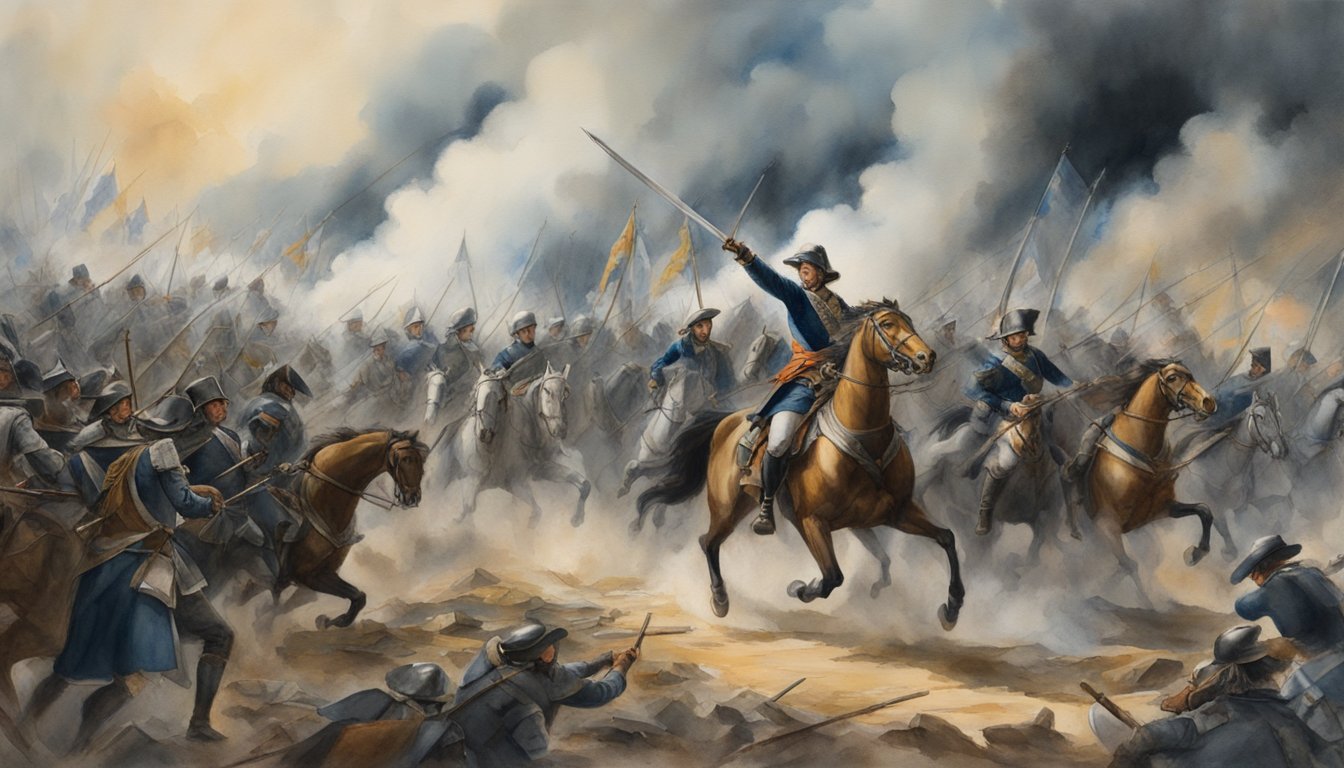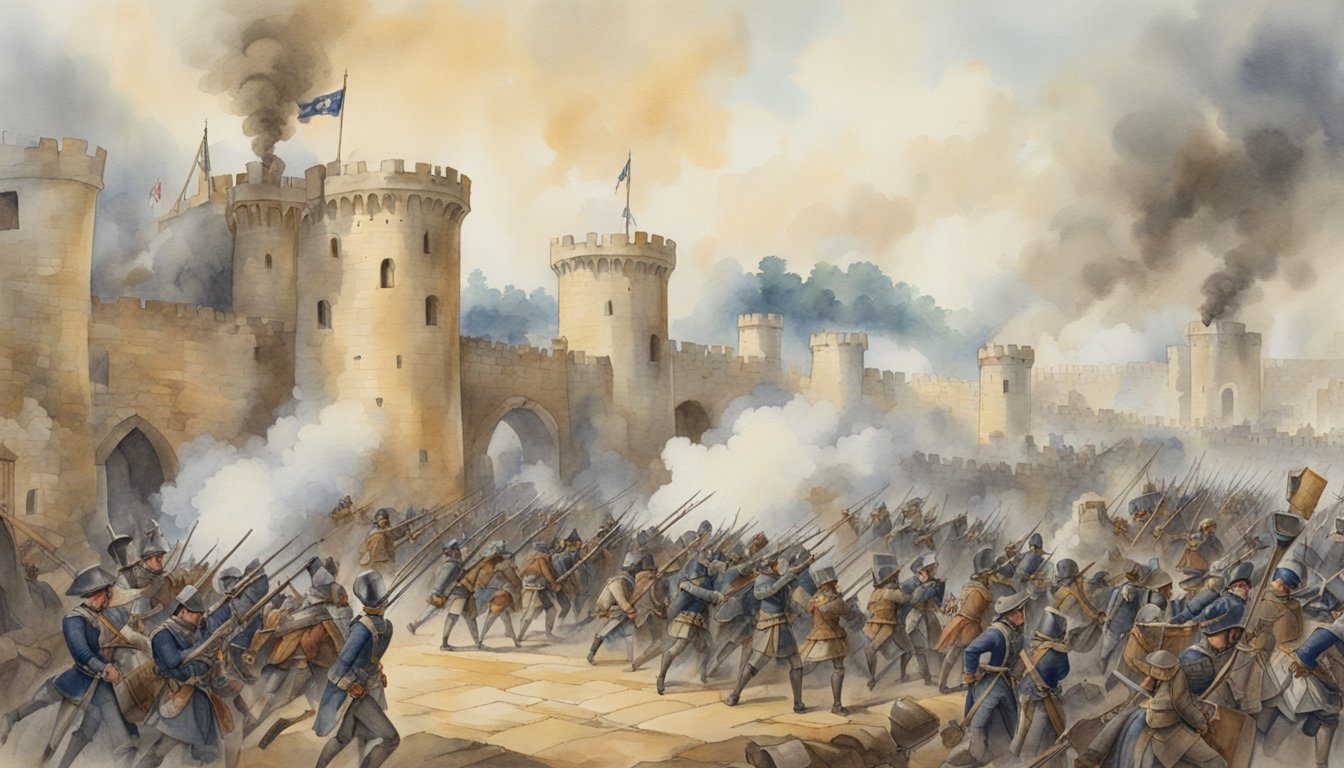Thomas Fairfax: Revolutionary Leader and Military Strategist

Thomas Fairfax, also known as the 3rd Lord Fairfax of Cameron, played a pivotal role in the English Civil War. His leadership was instrumental in many victories for the Parliamentary forces.
Most notably, he led them to success in the critical Battle of Naseby, which was a turning point in the conflict.

Fairfax’s early life in Yorkshire set the stage for his military career.
Coming from a noble family, he quickly rose through the ranks, becoming a distinguished leader in the New Model Army.
His tactical skill and bravery made him a respected figure among his troops and peers alike.
After the war, Fairfax’s political influence grew.
He played a significant role in the Restoration of Charles II in 1660, showing his complex relationship with both the monarchy and Parliament.
Today, Fairfax’s legacy as a military leader and his controversial political choices continue to spark interest and debate.
Key Takeaways
- Fairfax led major victories for Parliament during the English Civil War.
- He was a key figure in the New Model Army.
- His legacy includes both military success and political controversy.
Early Life and Background

Thomas Fairfax was born into an aristocratic family in Denton, North Yorkshire.
His early years were shaped by his family’s military background, his education at Cambridge, and crucial military training under Sir Horace Vere.
Family and Lineage
Thomas Fairfax was born on January 17, 1612.
His father was Ferdinando Fairfax, the 2nd Baron Fairfax of Cameron.
His mother was Mary Sheffield.
The Fairfax family had a strong military tradition.
Ferdinando Fairfax played a significant role in the English Civil War.
Thomas’ exposure to military life began at a young age due to his father’s influence.
Thomas Fairfax married Anne de Vere on June 20, 1637, strengthening his ties with prominent military figures.
They had one daughter, continuing the family’s lineage.
Education at Cambridge
Thomas Fairfax attended Cambridge, where he was enrolled at St John’s College.
The education he received was rigorous and comprehensive, preparing him for his future roles.
St John’s College is one of the largest colleges at Cambridge University.
It was founded in 1511 and is known for its academic excellence.
During his time there, Thomas Fairfax likely studied a range of subjects, including classical languages, literature, and philosophy.
The analytical skills and broad knowledge gained at Cambridge helped Thomas in his military and political career.
Military Training under Sir Horace Vere
Crucial to Thomas Fairfax’s development as a military leader was his training under Sir Horace Vere.
Sir Horace was a renowned English soldier and tutor to Fairfax.
Vere’s training emphasized discipline, strategy, and leadership.
Under his guidance, Thomas Fairfax participated in several campaigns, honing his skills on the battlefield.
These early experiences under an experienced commander like Sir Horace Vere were invaluable.
They helped Fairfax become an adept and capable military leader.
Rise to Prominence
Thomas Fairfax distinguished himself through crucial military engagements and leadership during the English Civil War.
His early career and notable victories set the foundation for his rise.
Initial Military Engagements
Thomas Fairfax began his military career fighting for the Protestants in the Netherlands.
His skills were soon recognized, and upon returning to England, he commanded a cavalry troop for King Charles I during the First Bishop’s War against Scotland in 1639.
Fairfax’s early experiences honed his tactical abilities and earned him a reputation as a competent leader.
In 1642, Fairfax became involved in the political turmoil, choosing the Parliamentarian side.
His engagements in Yorkshire, including battles near York, Leeds, and Wakefield, showcased his strategic acumen.
At the Battle of Adwalton Moor, although faced with a setback, his resilience in the following campaigns cemented his status.
His efforts in securing Hull demonstrated his tactical flexibility and determination.
Role in the English Civil War
By 1645, Thomas Fairfax emerged as a central figure in the Parliamentarian forces.
He was appointed commander-in-chief of the New Model Army, a formidable military force.
Fairfax’s leadership was instrumental in key victories, notably the Battle of Naseby, which proved decisive for the Parliamentarians.
His collaboration with Oliver Cromwell further strengthened the army’s effectiveness.
Under Fairfax’s command, the New Model Army was disciplined and strategic.
His ability to inspire his troops and maintain order led to several important victories, contributing significantly to the Parliamentarian cause.
These successes not only marked him as a military genius but also propelled him to a position of considerable influence within England.
Commander of the New Model Army
Thomas Fairfax played a crucial role as the Commander of the New Model Army, shaping its formation and leading it to significant victories during the English Civil Wars.
Formation of the New Model Army
The New Model Army was formed in 1645 by the Parliamentarians during the English Civil Wars.
The Self-Denying Ordinance meant that members of Parliament had to resign their military commands, which allowed Thomas Fairfax to be appointed as the commander.
Fairfax’s leadership was vital in organizing the army, which was different from others as it consisted of professional soldiers.
Fairfax focused on discipline and merit, unlike the part-time militia known as Trained Bands.
The forces were better trained, more professional, and motivated by both pay and a sense of purpose.
This unique approach made a significant difference in their effectiveness on the battlefield.
Battle Strategy and Key Victories
Fairfax’s strategy relied on mobility and the use of experienced officers.
One of his key tactics was to engage the enemy decisively, rather than relying on siege warfare.
His command style emphasized aggressive actions and quick decisions.
The Battle of Naseby in 1645 was a crucial victory for Fairfax and the New Model Army.
They decisively defeated the Royalist forces, a turning point in the war.
His leadership also shone in other battles, like the Battle of Marston Moor, where his strategic foresight led to significant wins.
Fairfax’s approach ensured a series of critical victories that weakened the Royalist cause and paved the way for the eventual success of the Parliamentarians.
Critical Battles and Campaigns

Thomas Fairfax was an influential military leader who played a pivotal role in key battles of the English Civil War.
His strategic acumen and leadership in battles such as Marston Moor, Naseby, and Langport were crucial in securing victories for the Parliamentarian forces.
The Siege of York and Marston Moor
In 1644, Thomas Fairfax participated in the Siege of York along with the Scottish Covenanters and forces led by Oliver Cromwell.
This concerted effort aimed to weaken the Royalist stronghold in northern England.
The climactic Battle of Marston Moor, fought on July 2, 1644, saw Fairfax’s tactics and coordination with Cromwell’s cavalry proving decisive.
The Parliamentarians’ victory not only secured control of the north but also highlighted Fairfax’s prowess as a commander.
Naseby: The Decisive Turning Point
The Battle of Naseby on June 14, 1645, was a turning point in the English Civil War.
Thomas Fairfax, as commander of the Parliamentarian New Model Army, showcased masterful leadership.
At Naseby, Fairfax’s forces decisively defeated King Charles I’s Royalist troops.
The battle was marked by Fairfax’s effective use of infantry and cavalry, coordinated with Oliver Cromwell’s iron discipline.
This victory crippled the Royalist army and shifted the war’s momentum in favor of Parliament.
Success at Langport and Nantwich
The Battle of Langport on July 10, 1645, demonstrated Fairfax’s continued effectiveness.
By outmaneuvering the Royalist forces, Fairfax ensured a Parliamentarian victory, further weakening the Royalist position.
Earlier, at the Battle of Nantwich in January 1644, Thomas Fairfax led a successful relief of the town, securing a crucial stronghold for Parliament.
This win bolstered his reputation as a capable and reliable military leader.
These victories, marked by strategic brilliance and tactical skill, solidified Thomas Fairfax’s legacy as a key figure in the Parliamentarian cause.
Engagements Against Royalist Strongholds

Sir Thomas Fairfax played a vital role in weakening Royalist power through strategic military actions.
Key campaigns in the south and west, as well as significant operations in cities like Leicester, highlight his impact.
Confrontations in the South and West
Fairfax’s military strategies significantly impacted Royalist strongholds in the south and west of England.
In Colchester, he led a successful siege in 1648, overcoming a well-defended Royalist position.
In Taunton, his forces lifted the siege laid by Royalist troops, providing crucial support to the Parliamentary cause.
This victory helped secure the southwest for Parliament.
Fairfax’s tactics often involved surrounding Royalist forces, cutting off supplies, and launching decisive assaults.
These methods resulted in crucial Parliamentary victories and the eventual diminishing of Royalist control in these regions.
Leicester and the Fairfaxian Expeditions
In 1645, Fairfax’s army launched an expedition to retake Leicester, which had fallen to Royalist forces.
This campaign was critical in disrupting Royalist communications and supply lines.
Fairfax’s expeditions were marked by swift and decisive actions, ensuring minimal loss while achieving significant results.
By capturing key locations, he steadily eroded Royalist strength.
In the latter stages of the war, Fairfax’s operations continued to be successful, forcing major Royalist centers like Oxford to capitulate.
His relentless pursuit and strategic planning led to the eventual collapse of Royalist resistance, demonstrating his effectiveness as a military commander.
Fairfax’s Political Role

Thomas Fairfax played a significant role in English politics, especially during the English Civil Wars and the period that followed.
His involvement in Parliament and the Council of State, as well as his actions during the Second Civil War, were crucial.
In Parliament and the Council of State
Fairfax was a member of the English Parliament and served on the Council of State.
He contributed to discussions and made decisions that shaped England’s governance.
As the leader of the New Model Army, his military successes gave him considerable influence.
In 1647, Fairfax helped ensure the Army’s interests were represented by negotiating with Parliament.
Although more moderate compared to some counterparts, he played a pivotal role in sustaining a balance between military and political powers.
During the Commonwealth, Fairfax continued his political involvement.
Despite his military background, he advocated for a fair and balanced government, often mediating between different factions.
His leadership in the Council of State was marked by his commitment to stability and rule of law.
The Second Civil War and its Aftermath
Fairfax’s actions during the Second Civil War were crucial.
The war erupted in 1648 due to disagreements between Parliament and King Charles I. Fairfax led Parliamentarian forces to suppress Royalist uprisings effectively.
His victories were influential in maintaining Parliament’s control over England.
After the war, Fairfax faced a challenging political environment.
With rising tensions between different political groups, his moderate stance became evident.
He opposed extreme measures, such as the execution of Charles I, although he did not actively prevent it.
In 1660, during the Restoration of Charles II, Fairfax played a key role.
He supported the reinstatement of the monarchy, helping to ensure a smooth transition.
His actions were instrumental in restoring peace and stability to a nation torn by years of conflict.
Retirement and Final Years

Thomas Fairfax stepped away from his military role and public life, opting for a quieter existence at his Yorkshire estate.
Withdrawal from Public Life
After the English Civil Wars, Thomas Fairfax received a pension of £5,000 a year.
He retired to Nunappleton in Yorkshire.
This estate became his sanctuary.
He spent much of his time here, far from the political upheavals.
He focused on personal and local interests, avoiding the limelight.
This withdrawal marked the end of his significant public engagements.
Fairfax still maintained connections with key figures but kept a low profile.
His time at Nunappleton allowed him to reflect on his past actions and decisions during the war.
Reflections and Death
During his retirement, Fairfax spent many days contemplating his years in service.
Living at Denton Hall, he had ample space to think and maintain correspondence with old allies and friends.
Denton Hall provided a comfortable retreat.
Fairfax’s later years were peaceful but filled with reflection.
He passed away in 1671, marking the end of a significant era in English history.
His death felt by many who respected his military achievements and leadership.
He was buried with honors, remembered for his role in shaping the future of England.
The Fairfax Legacy
Thomas Fairfax, also known as Lord Fairfax of Cameron, played a significant role in shaping British military tactics and left a notable cultural and historical imprint.
Influence on British Military Tactics
Thomas Fairfax was an adept commander during the English Civil War.
As leader of the New Model Army, he led Parliament’s forces to key victories, including the Battle of Naseby, which was crucial for defeating the Royalists.
You can learn more about his military career on Wikipedia.
Fairfax’s strategies emphasized discipline and professionalism.
Under his leadership, the New Model Army became a well-organized and effective fighting force, introducing practices that influenced future British military tactics.
His focus on meritocracy within the army ranks was innovative.
Promotions were based on skill and dedication rather than social status, which was uncommon at the time.
This approach not only contributed to the army’s success but also set a precedent for future military organization.
Cultural and Historical Impact
Fairfax’s impact extended beyond the military.
His legacy included mentoring George Washington, which had a lasting influence on the future first President of the United States.
Their relationship shaped Washington’s development, as noted by the Mount Vernon article.
You can also see the legacy of Lord Fairfax in Virginia.
Fairfax County and several other places in northern Virginia bear his name, underlining his enduring cultural and historical influence.
He is commemorated in places like Christ Church in Winchester, Virginia, where he is buried (American Battlefield Trust).
His contributions and connections continue to be remembered and studied today.
Controversies and Political Tensions
Thomas Fairfax, a critical figure in the English Civil Wars, dealt with several political and controversial issues.
Key events included his complicated role in the Trial of King Charles I and his sometimes strained relationship with Oliver Cromwell.
Fairfax and the Trial of King Charles I
Fairfax had a notable stance during the Trial of King Charles I. Although he was a leader in the Parliamentary Forces, he showed much reluctance to the idea of executing the king.
His Presbyterian beliefs clashed with the more radical factions.
During the trial, Fairfax’s absence was significant.
His wife, Anne, however, attended and openly protested.
Fairfax’s hesitation revealed the fractures within the Parliamentary leadership.
He questioned the legitimacy of trying a monarch.
Despite his reservations, the trial proceeded, leading to the king’s execution.
This event marked a key turning point in English history, highlighting Fairfax’s internal conflicts and the growing divisions within the Parliamentary Forces.
Relations with Oliver Cromwell
Fairfax’s relationship with Oliver Cromwell was complex.
Both were instrumental in the Parliamentary victory over the Royalist Forces, and they initially worked well together.
However, tensions emerged over political goals.
Cromwell’s increasing power and push for a more radical political agenda created friction.
Fairfax was cautious of Cromwell’s rise and the army’s political role.
His moderate stance contrasted sharply with Cromwell’s vision for the future.
Eventually, this led Fairfax to resign his command in 1650, reflecting deep-rooted political and personal differences.
This resignation underlined the shifting power dynamics within the Parliamentary leadership and the evolving nature of England’s political landscape.
Personal Life and Relationships

Thomas Fairfax, an important figure in the English Civil War, had a rich personal life shaped by his family and his various relationships.
Known for his strong bond with Lady Fairfax and his interactions through correspondences, Fairfax’s personal views also played a role in shaping his character.
Family Affairs
Thomas Fairfax was born in Yorkshire in 1612.
He was the eldest son of Ferdinando Fairfax, 2nd Lord Fairfax.
Growing up in a noble family, Fairfax had strong family ties, especially with his wife, Lady Fairfax.
They married young and shared similar views on many political issues.
Lady Fairfax was known for her spirited nature, often standing by her husband’s side during challenging times.
Together, they had several children, and their home was a center of political and social activity.
The Fairfax family was deeply intertwined with the political sphere, often engaging with other nobles like the Marquess of Newcastle.
Correspondence and Personal Views
Thomas Fairfax was also known for his extensive correspondence.
He communicated with various political and military figures, voicing his opinions and strategies.
His letters reveal a man deeply committed to his principles and the cause of Parliament during the Civil War.
Fairfax’s personal views were heavily influenced by his upbringing and his time spent at Cambridge and Gray’s Inn.
Despite his military role, he often sought peaceful resolutions.
Later in life, he withdrew from public life but briefly returned to support the Restoration of the monarchy, showing his complex and evolving stance on England’s political future.
His relationship with figures like George Monck also demonstrates his continuous influence.
Frequently Asked Questions
Here, you will find detailed information about Thomas Fairfax, his contributions to history, and his personal life.
What was Thomas Fairfax famous for?
Thomas Fairfax, 3rd Lord Fairfax of Cameron, is best known as a commander in the Parliamentary army during the English Civil War.
His leadership in battles such as the Battle of Naseby was crucial for the Parliamentarian victory.
How did Thomas Fairfax contribute to the English Civil War?
Thomas Fairfax played a significant role as the General of the New Model Army.
His military strategies and discipline greatly contributed to the defeat of the Royalist forces.
You can learn more about his impressive career and achievements here.
Who was Thomas Fairfax’s spouse?
Thomas Fairfax married Anne Vere, the daughter of Horace Vere, 1st Baron Vere of Tilbury.
Their marriage in 1637 connected him with influential families and supported his political and military career.
Can you trace the lineage of Lord Fairfax’s descendants?
Lord Fairfax’s lineage includes several notable descendants.
His family played significant roles in various historical and political contexts.
You can find more specific information about his descendants and their impact here.
Where is Thomas Fairfax’s final resting place?
Thomas Fairfax is buried at Bilbrough, near York, in England.
His grave can be visited at All Saints’ Church in Bilbrough, where his legacy continues to be honored.
Did Thomas Fairfax have any involvement in the regicide of King Charles I?
Thomas Fairfax did not directly participate in the trial or execution of King Charles I. Although he was a leading figure in the Parliamentary cause, he did not support the decision to execute the King.
For more information, check here.
By exploring these areas, you gain a clearer picture of Thomas Fairfax’s historical significance and his personal life.






